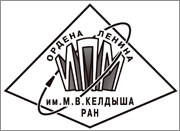|
|
Preprints of the Keldysh Institute of Applied Mathematics, 2009, 066, 24 pp.
(Mi ipmp337)
|
 |
|
 |
Investigation of the accuracy of the vision system assigned for testing low-frequency accelerometers onboard a spacecraft
V. L. Levtov, A. A. Boguslavsky, V. V. Sazonov, S. M. Sokolov, Yu. N. Glotov
Abstract:
We consider the space experiment on determining quasi-steady accelerations by video images of a freely moving object. A pellet moves in the cubic box, which is fixed on a spacecraft body and has two transparent adjacent walls. The TV camera shoots its movement. The camera is placed opposite to a transparent wall; the mirror is placed angle-wise to another transparent wall is in the camera field of vision. This optical system is able to capture images of the pellet from two points of view in a frame. Special processing of each frame gives coordinates of the pellet center in the camera coordinate system. We process a sequence of frames, obtained in an interval of continuous shooting, in the following way. Using the least squares method, we construct quadratic parabolas that approximate time dependence of pellet coordinates. The coefficients of time squares equal a half of corresponding components of acceleration. The similar experiment was carried out onboard the spacecraft Foton M-3, but it was made rather differently. Its post-flight processing demanded a lot efforts of investigators. Below, we estimate the accuracy of the vision system and discuss the ways of automation of measurement process in order to make it online onboard a spacecraft.
Citation:
V. L. Levtov, A. A. Boguslavsky, V. V. Sazonov, S. M. Sokolov, Yu. N. Glotov, “Investigation of the accuracy of the vision system assigned for testing low-frequency accelerometers onboard a spacecraft”, Keldysh Institute preprints, 2009, 066, 24 pp.
Linking options:
https://www.mathnet.ru/eng/ipmp337 https://www.mathnet.ru/eng/ipmp/y2009/p66
|

| Statistics & downloads: |
| Abstract page: | 106 | | Full-text PDF : | 45 | | References: | 30 |
|




 Contact us:
Contact us: Terms of Use
Terms of Use
 Registration to the website
Registration to the website Logotypes
Logotypes








 Citation in format
Citation in format 